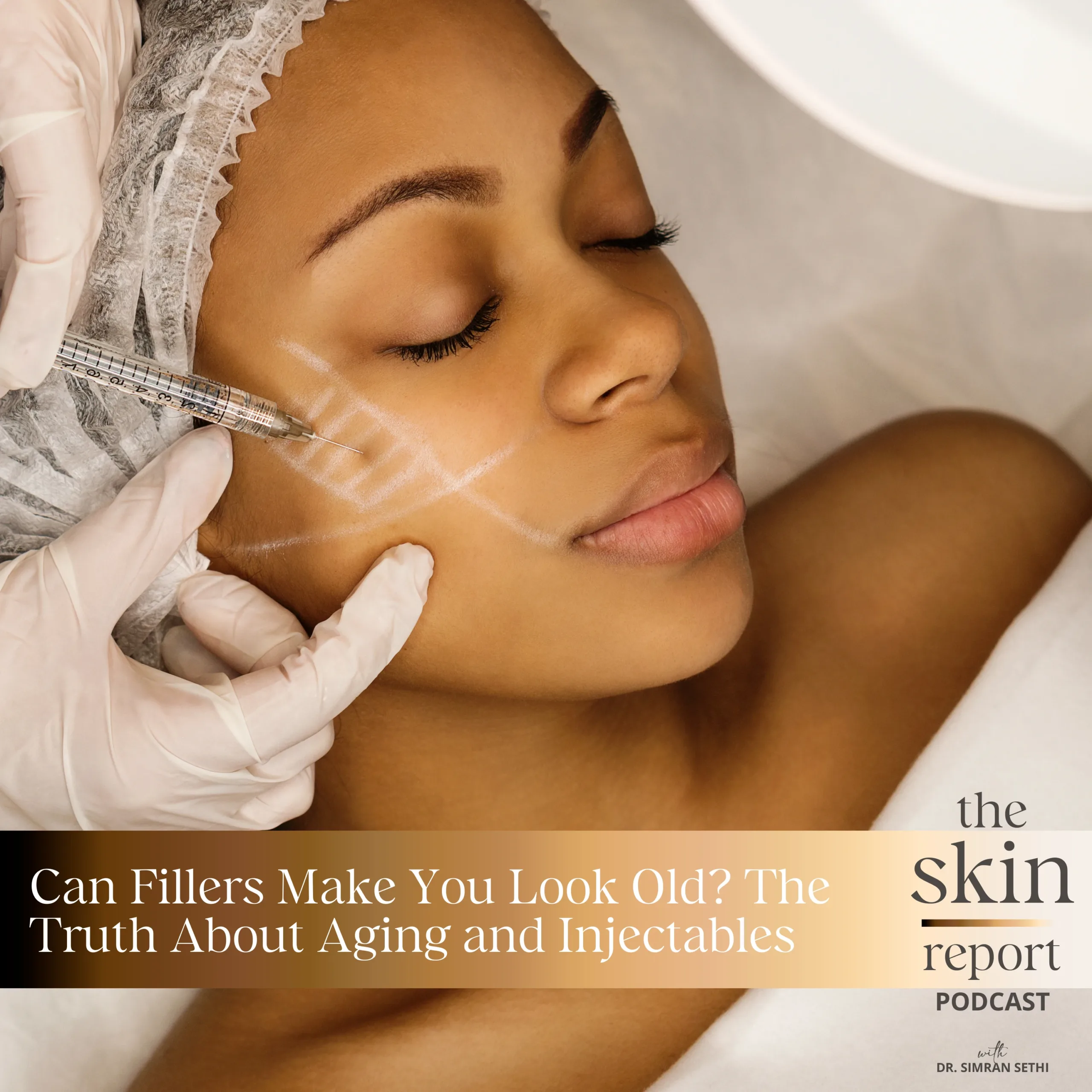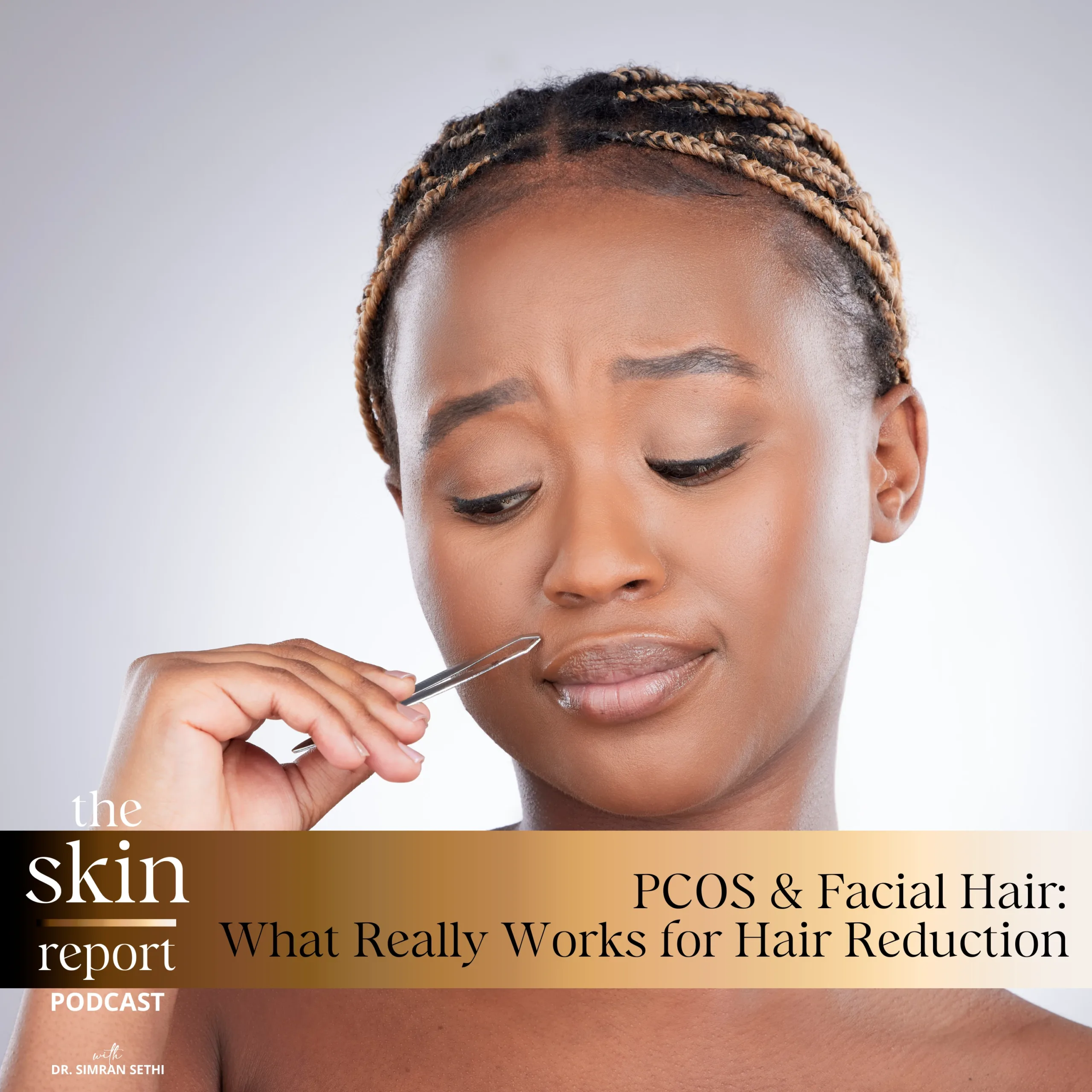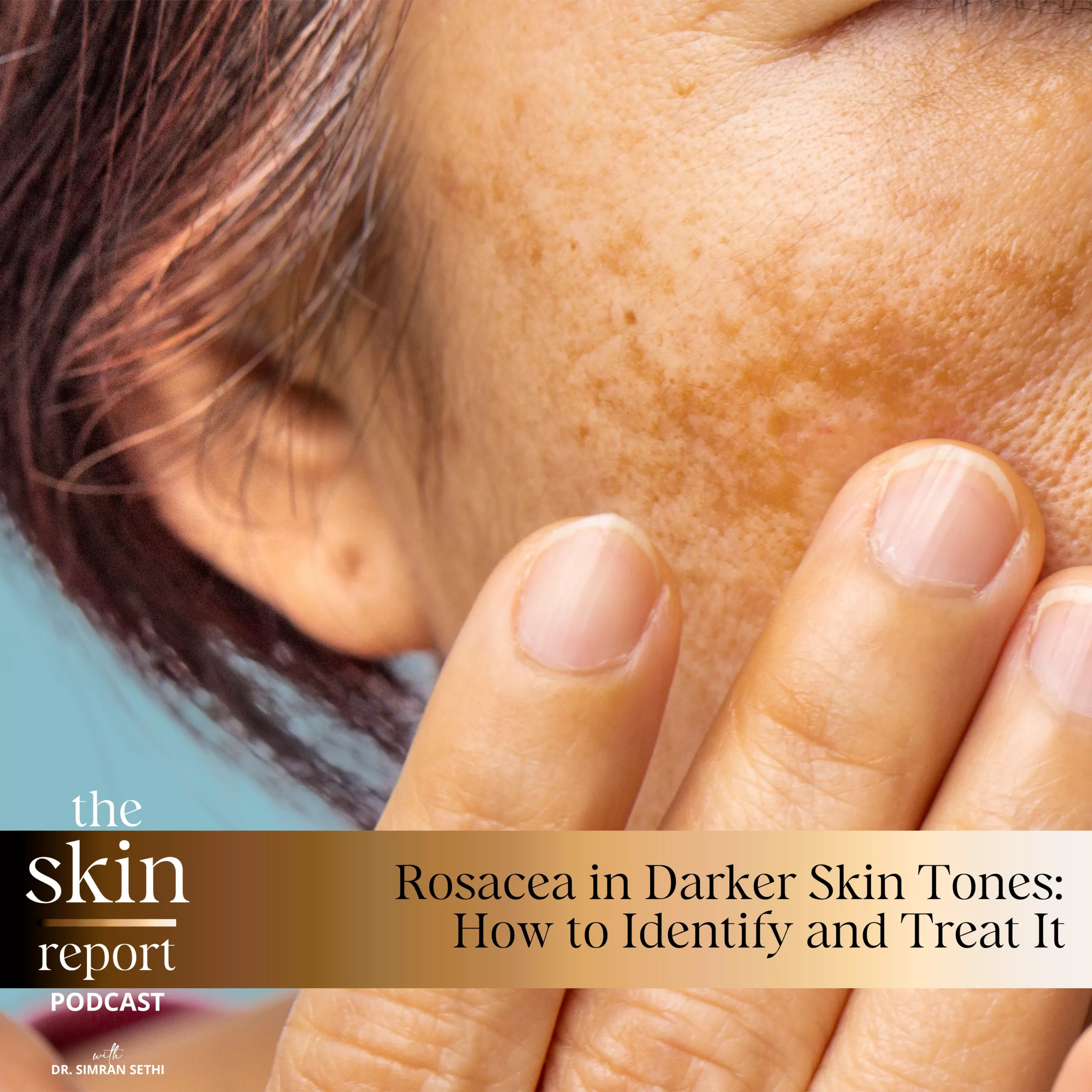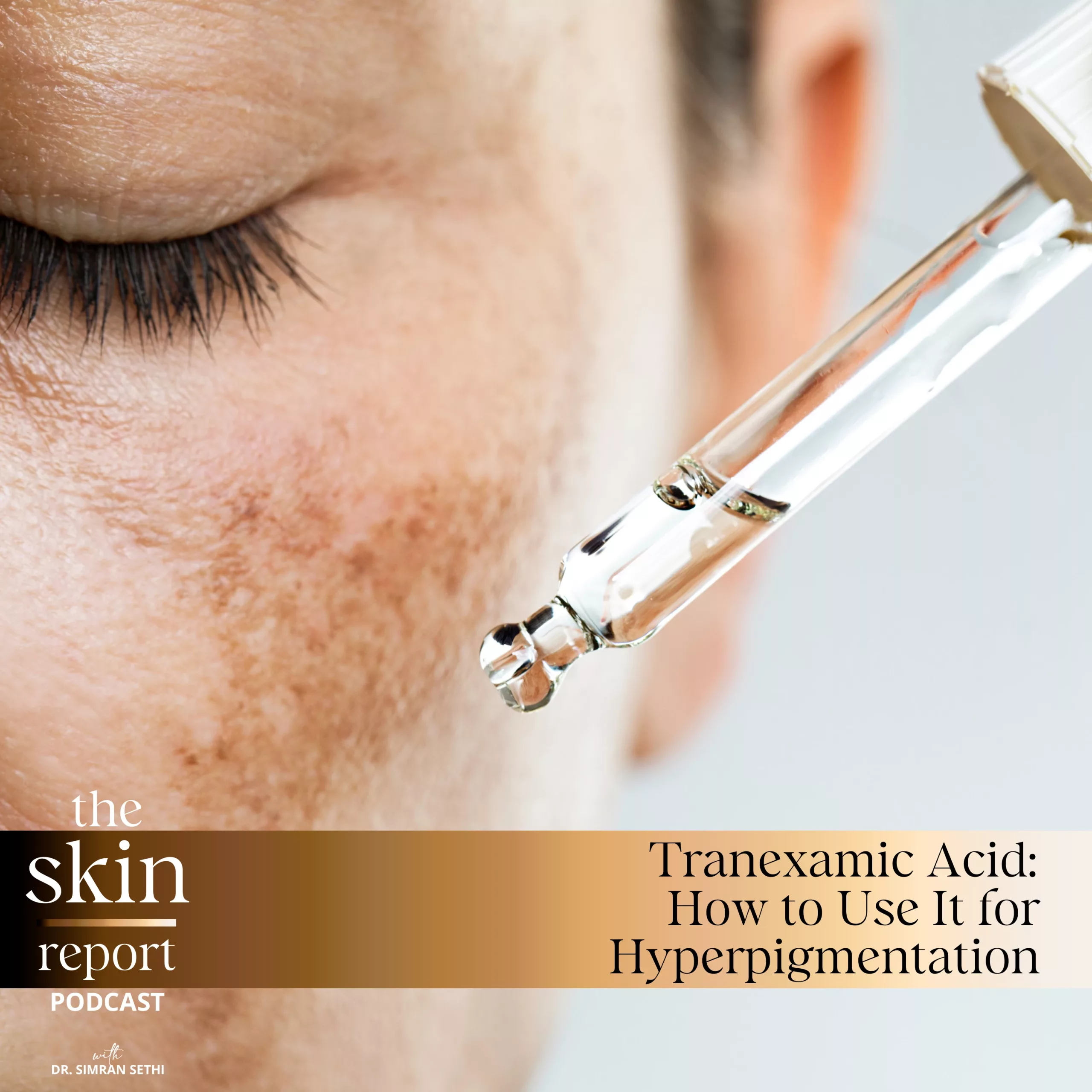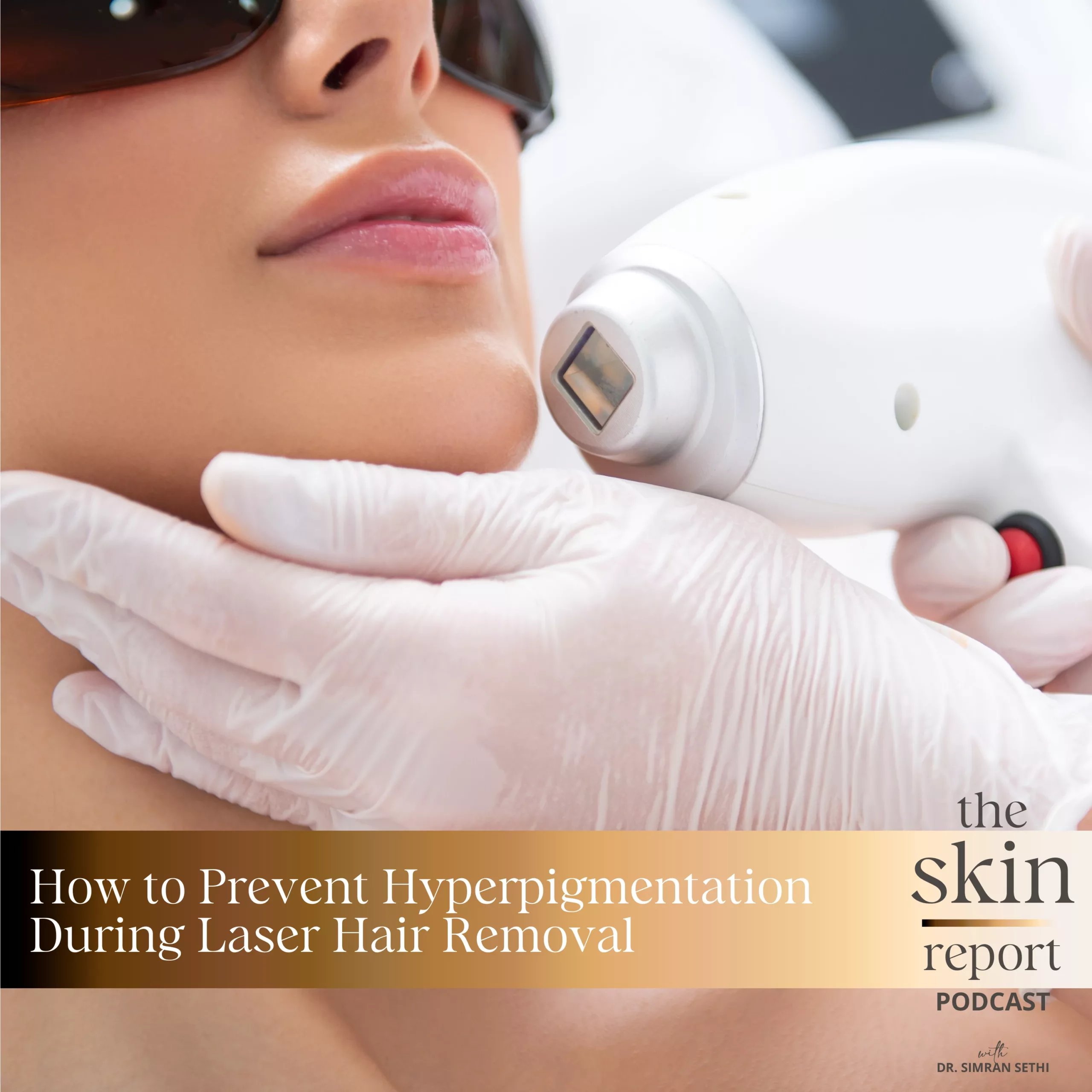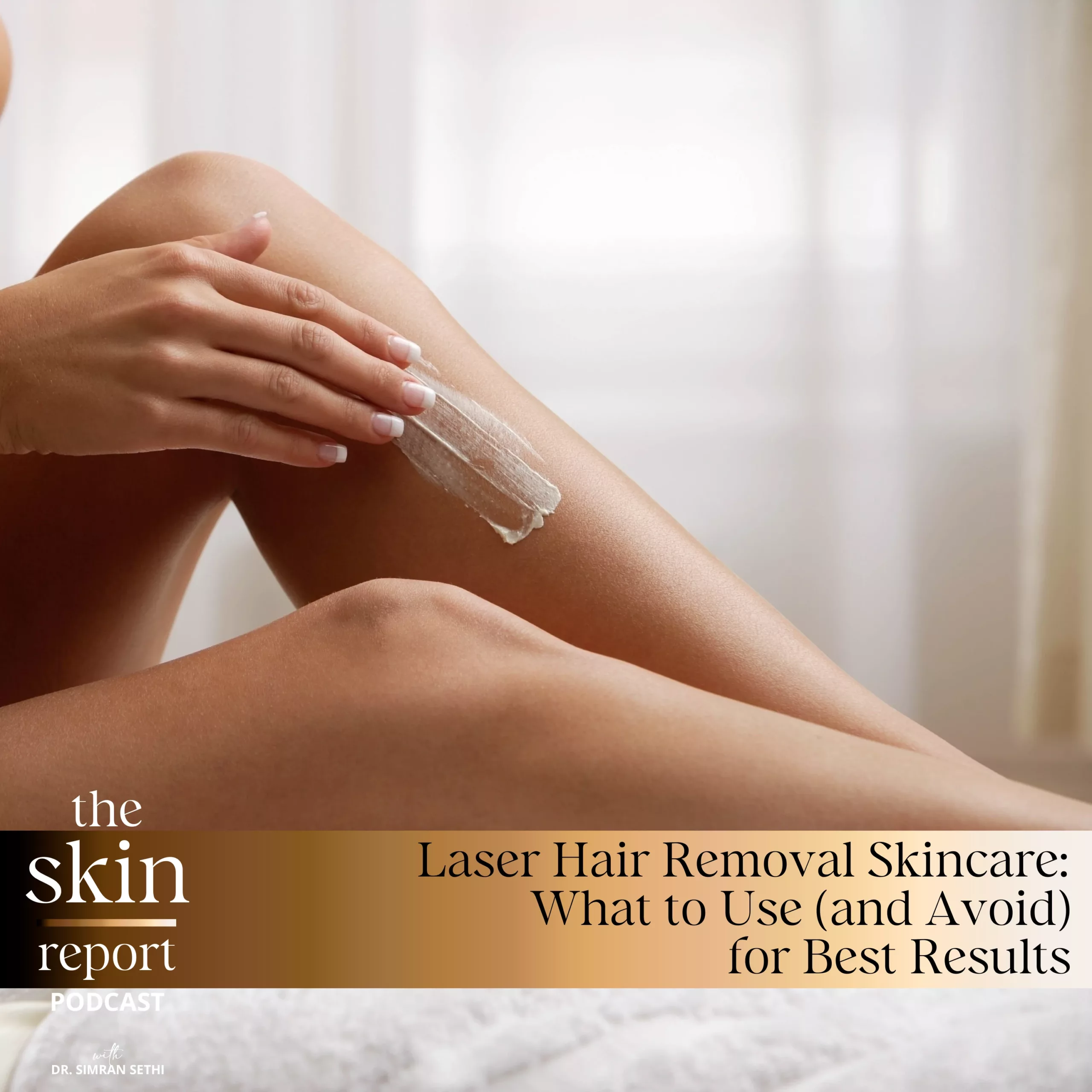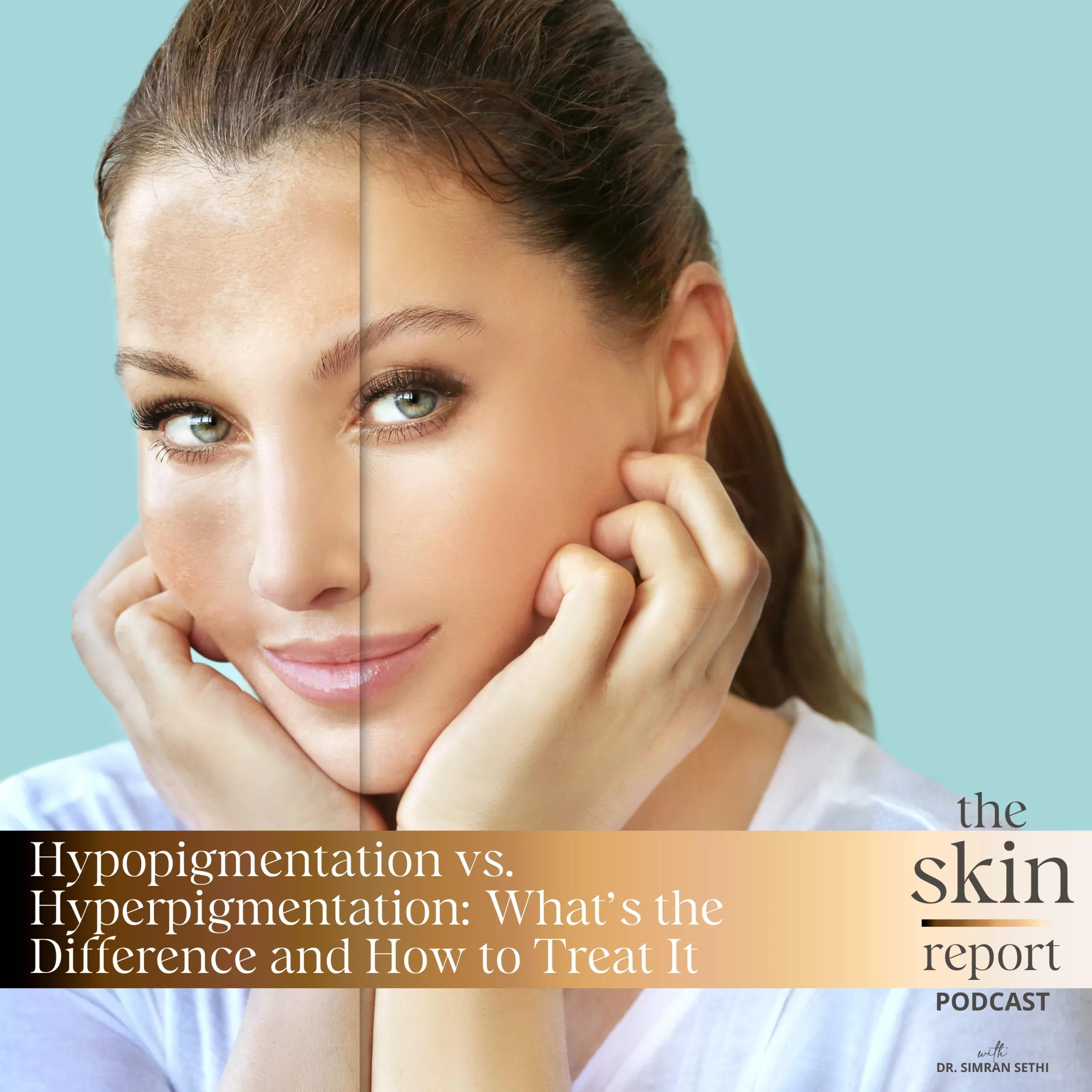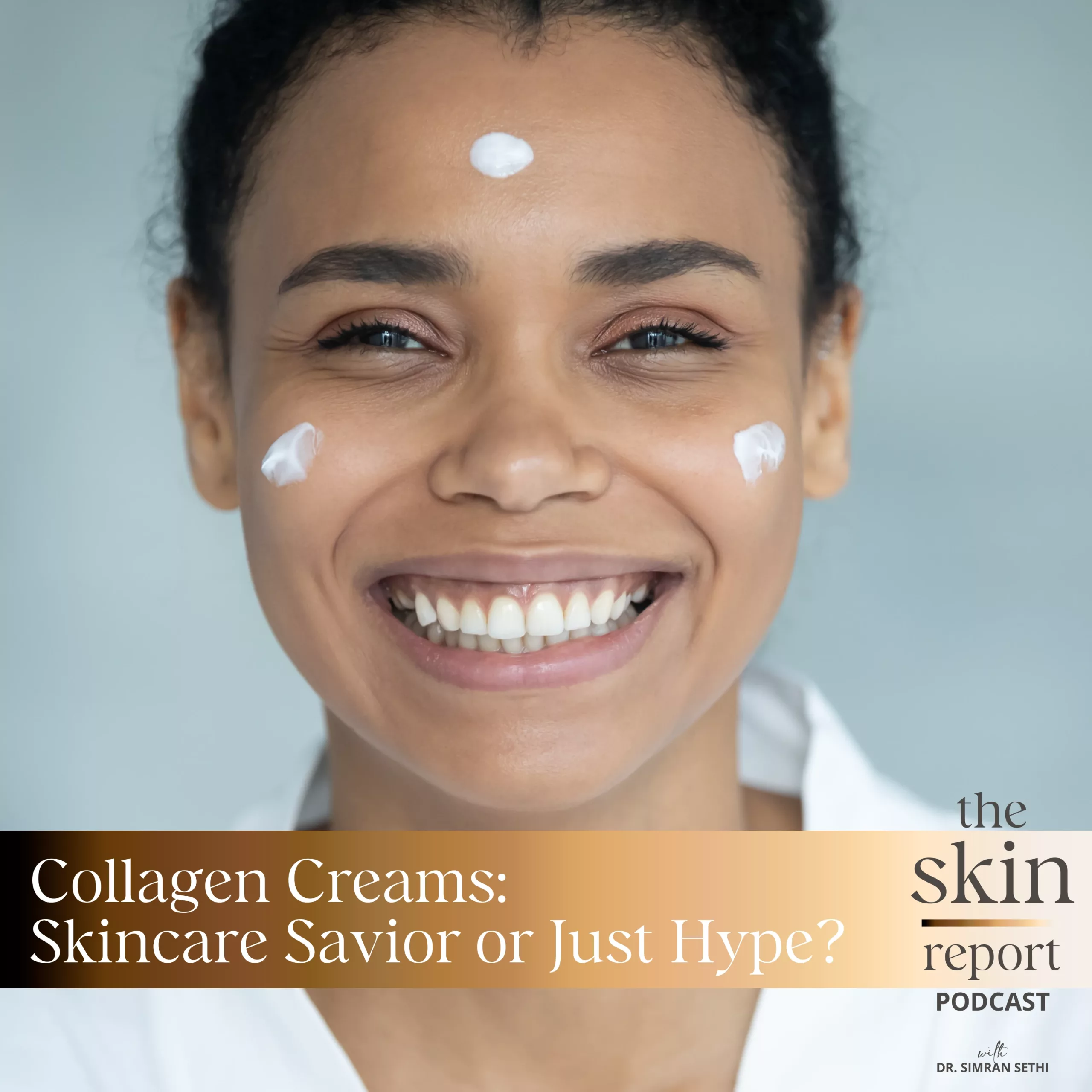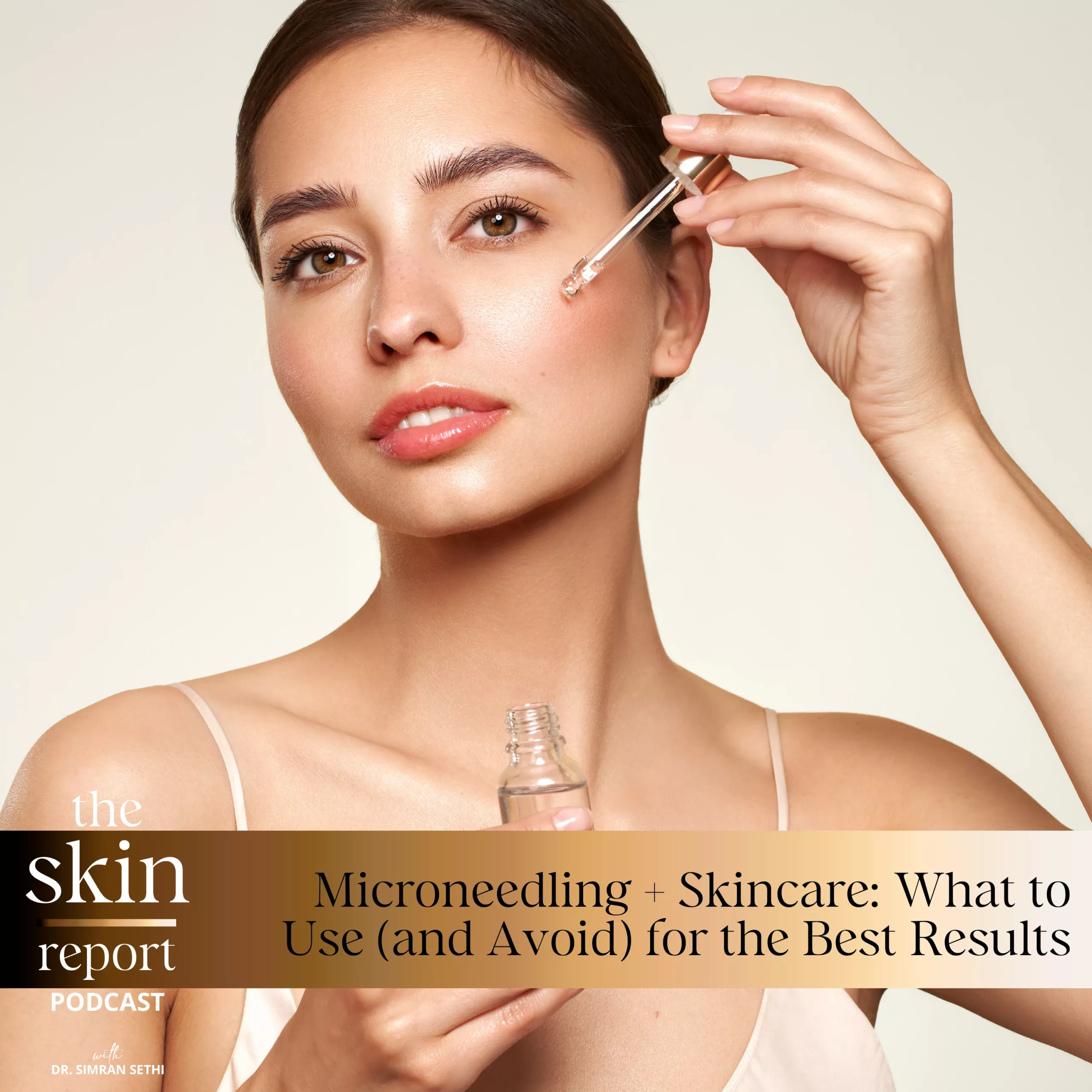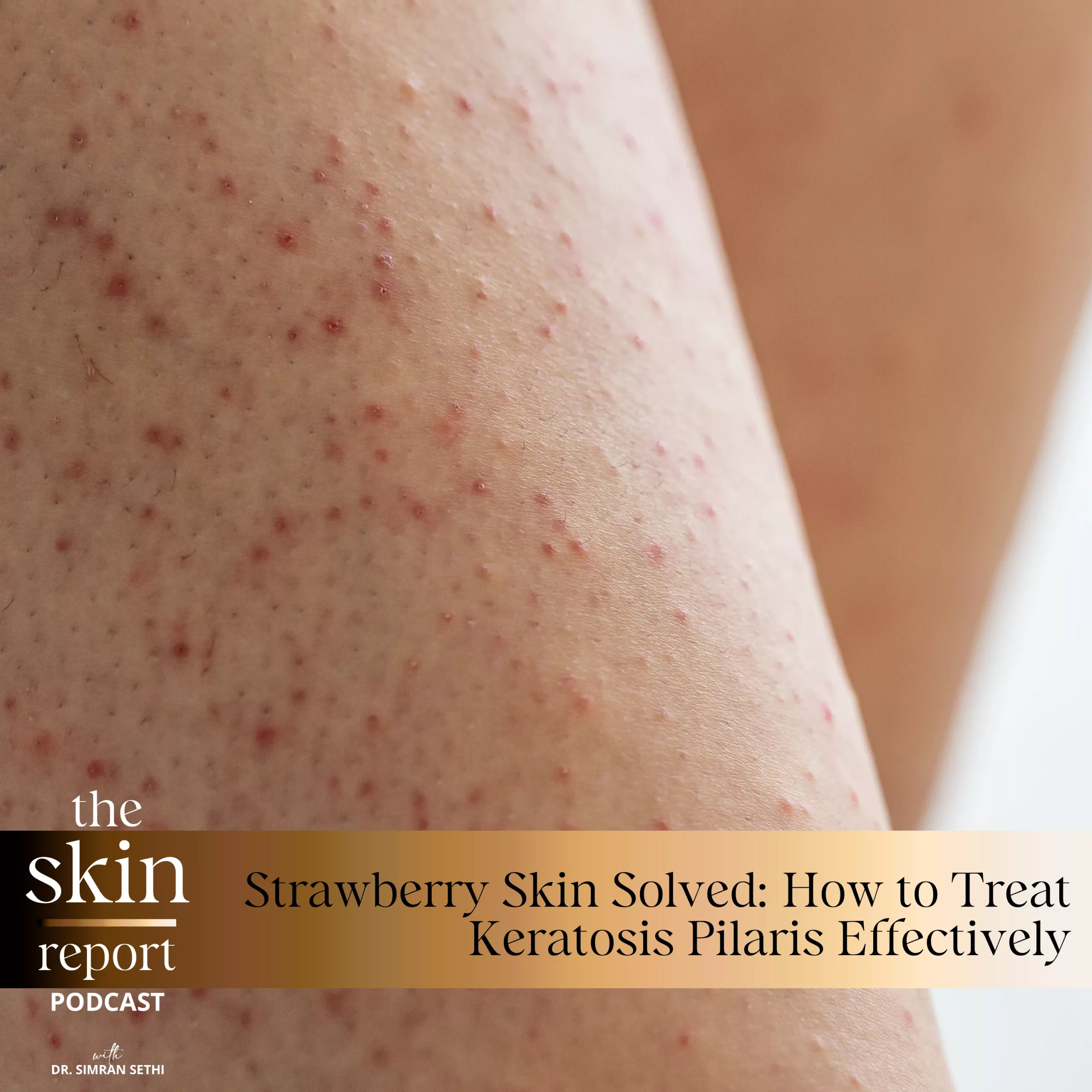Melasma reacts differently to skincare products, treatments, and ingredients than normal skin. Because of this, it can be challenging to decipher between a skincare method that will help your skin and one that will harm it. Still, melasma can have impacts on the skin, such as hyperpigmentation, skin sensitivity, and more, that affect the confidence of those with it. So what safe practices can people with melasma incorporate into their skincare to improve the look and feel of their skin?
The Skin Report is a podcast created to educate listeners on methods to improve skin health for people of all ethnicities and ages. This week’s host Dr. Sethi continues with her October series on melasma by sharing information about safe melasma skin care practices. She shares her insight on safe ingredients like vitamin C, hyaluronic acid, and even retinol for treating the impacts of melasma. She also discusses the importance of moisturizer and blue light protection for the skin and building a strong skin barrier. Listeners will even hear about how chemical peels and microdermabrasions affect hyperpigmentation and some safe and effective way to lighten dark melasma patches.
Beauty Instagram: https://www.instagram.com/renewmd_beauty/
RenewMD Beauty Medical Spas, California: https://renewmdwellness.com/
This transcript was exported on October 17, 2022 -view latest version here.
Skincare can sometimes feel overwhelming, whether it’s finding the right products, ingredients, or treatments, there is a lot out there, but not always for women of color. That’s why I set out to educate myself and others so that we can all feel beautiful in our skin. Hello and welcome to The Skin Report. I’m Dr. Simran Sethi, an internal medicine doctor, mom of three and CEO and founder of RenewMD Medical Spas and Skin by Dr. Sethi.
If you’ve been following our show, you may know that we did a four part series in September on skin of color and the skincare industry. I highly suggest going back and listening to that series as we share some valuable insights on racist practices in the beauty industry, common concerns for melanated skin and how to overcome them.
For the entire month of October, we will be launching a new series on one of those common yet misunderstood and under research skin conditions, melasma. This will be our third episode in the series and I highly suggest going back to the beginning of October to listen to the whole series as it builds upon itself. As a quick recap, we’ve covered the science behind melasma, how it occurs, who experiences it, and ways to prevent or reduce its appearance. We ended episode two with mentioning things to avoid in our skincare products and procedures. For today’s episode, I’d like to focus on what we can incorporate to help with melasma from product to procedure.
If you recall from our previous episode, the skin in the melasma lesions show signs of protein breakdown, dryness and other factors that mimic aging skin. While you may have youthful skin otherwise, the patches of pigmentation on your skin needs care like that for mature skin. What can we add to our skin care routine that would help treat the impacts of melasma such as hyperpigmentation, sensitivity, and more. Likely, you may already have a few of these ingredients in your bathroom. All you need to do is harness them in a way that would be more beneficial.
The first step I would add or adjust to a routine is a vitamin C serum. While vitamin C is always great for improving the look of wrinkles and dark spots, it can be particularly helpful in promoting collagen and fighting the oxidative damage from ultraviolet, or UV, and heat exposure. UV and heat exposurecan trigger melasma flareups, so it’s always great to have a vitamin C serum on your side. Serums that contain botanical lighteners like kojic acid, a mushroom extract, arbutin and bearberry can slightly reduce melanin production without aggravating melanocytes.
Another great weapon against melasma is some form of blue light protection. As we discussed in our previous episode, blue light screens are great for melasma patients, but so is providing your skin with the armor it needs. Studies in skin of color have shown that blue light or HEV or visible light is responsible for increasing pigmentation and skin aging. Most of us think that when we are indoors, we do not need any protection, but newer studies have shown that exposure continues to increase with more time we all spend in front of screens and in indoor lighting.
Just two months ago, in August 2022, Frontiers in Aging published a study conducted by Oregon State University that track the impacts of long term blue light exposure to fruit flies. The study found that the exposed fruit flies suffered from more oxidative stress and death of retinal cells than the control group. The findings also revealed brain neurodegeneration even in mutant flies without eyes.
While this study has some limitations, as all do, I believe it paves an important pathway for further studies which will uncover similar findings, that blue light is damaging to more than just our eyes. I’d rather not take the risk with my skin and eyes, therefore, I’m a big proponent of protection against blue light for all my patients, but especially my melasma patients. Because of this, my line has multiple products that confer protection from blue light, including our hyaluronic acid serum, eye gel and the sunscreen. When we return, we’ll talk about one of my favorite ingredients and how it can help with your melasma without the risk of worsening it.
If you suffer from melasma, you may have already tried this ingredient and it may have backfired. That’s right. I want to talk about retinol. Many melasma patients try retinol as a way to reduce pigment. However, if used improperly, it can trigger more pigmentation. This can definitely happen as retinol traditionally dries skin, which causes our cells to react with more pigment. Then many melasma patients will abandon their retinol altogether, and I completely understand why. However, when harnessed correctly, retinol can truly reduce the impact of melasma.
Remember when we talked about how melasma ages skin, well, retinol has some powerful anti-aging effects. It increases skin cell turnover, boosting your skin’s ability to make new skin faster. It also magnifies your production of collagen to make your skin stronger. Therefore, having melasma in your skincare routine is important for anyone in general, but especially for those with melasma.
But how can we avoid drying out the skin and causing more issues? As always, I suggest going low and slow, a low concentration that you can incorporate into your routine over time. However, I also recommend favoring a product that pairs retinols with lipids to counteract its drying and inflammatory effects. The lipids in the retinol serum help prepare the parched skin that most people with melasma suffer from. For example, my retinol lipid complex does exactly that. You can find additional details in how to get the retinol lipid complex linked in the show notes of this episode.
Another great thing to keep in mind is moisturizer. As melasma tends are dry out and age the skin, keeping your skin hydrated is vital as mentioned in our previous episode. I do want to take a closer look at hydration for a moment as I think it’ll be helpful for those with and without melasma.
Have you noticed that when you apply moisturizer, your skin feels soft for a few hours, but then it gets dry later. As we are warm bodied, moisture is constantly evaporating from our skin to the air. To actually lock in that moisture, you need a moisture barrier, which is a key part of my skincare line. My hyaluronic acid serum is in each skincare system, acne prone, brightening, anti-aging and dry, because every skin type needs moisture locking. Hyaluronic acid is a great product to do that as its molecules act like a layer of small balls on the skin surface, blocking moisture from evaporating off the skin. In my hyaluronic acid Plump & Protect, we have additional moisture blocking with snow mushroom extract, which holds onto 1000 time its weight in water. Again, these products will be listed below if you’re curious.
The other thing that many people wonder about with moisturizers is whether the moisturizer should be water based or oil or lipid based. This is an important consideration as people with normal skin don’t need a lot of lipids in their moisturizer, but those with more mature skin and conditions like melasma should stick to moisturizers that are rich in phospholipids to better mimic the skin’s lipid barrier, which is more compromised in dry or mature skin. Building a stronger skin barrier with retinols and lipid rich moisturizers is effective, but these steps may not be enough to reduce pigmentation in melasma. When we return, we’ll discuss lightening creams, chemical peels and more.
In our September series on people of color, we discuss how the racist roots of the beauty industry have often fueled harmful and even dangerous practices for women of color, one of them being bleach. However, if you suffer from hyperpigmentation such melasma, it may be even more tempting to use a lightening cream with bleach. Not only does this aggravate the pigment issues further, it can be extremely dangerous to your health. How can we find a safe and effective way of lightening our dark patches that come with melasma? The answer botanical skin lighteners.
Botanical skin lighteners are a category of ingredients that have shown to gently reduce pigment reduction. Ingredients like kojic acid, a mushroom derivative, arbutin and licorice extract can help with offering a mild amount of pigment suppression without the risk of triggering extra skin sensitivities. I know many people with melasma or any kinds of dark spots from acne or sun are familiar with hydroquinone, which is a pharmaceutical skin lightener.
In the United States, hydroquinone must be prescribed to patients, but a formulation with 2% or low dose is available over thecounter. I use hydroquinone on my patients at higher doses, but this is really only safe under medical supervision. I found that hydroquinone can sometimes cause increased skin sensitivities, so it is important to start it under the guidance of a physician. Additionally, hydroquinone also needs to be used on and off. Otherwise, it will cause something called acanthosis, which is a skin condition that gives the grayish appearance to skin and can occur if hydroquinone is used indefinitely. For all these reasons, I prefer using botanical skin lighteners that are mild but do not lead to any adverse effects on a daily basis, and hydroquinone only under physician supervision.
An additional compound that is gaining popularity in melasma treatment is tranexamic acid or TXA. It’s a medicine used to reduce bleeding and, in other words, make blood clot more easily. It has shown promising results in reduction of pigmentation in melasma as we know that there is an increase in blood vessels and blood vessel size in melasma lesions, which can both increase the appearance of dark spots and promotes melanocyte activity. TXA can reduce the vasculature in melasma lesions and, as a result, cause melasma suppression. At this time, we know that this can be achieved with a topical application of TXA and, as we learn more, we will be able to start getting a better understanding of what dose of TXA is most effective too.
We’ve gone over a lot of information on topical skincare products and medicines that can help the skin in melasma. Next, stick around to hear how chemical peels and microdermabrasions can help or hurt your hyperpigmentation.
If you have melasma, you may look to chemical peels to help reduce pigment. For example, Cosmelan and melanage peels can help to reduce the appearance of melasma. However, chemical peels can be tricky as they only work when the melasma is in the epidermis where the peel can penetrate. Unfortunately, once patients seek treatments for their stubborn melasma, the melanite has usually deposited in the dermis. Hence, why it’s stubborn. In this regard, the pigment is deep and difficult to reach with most treatments including peels.
Additionally, chemical peels for melasma contain a high dose of hydroquinone, retinal, lactic or glycolic acids, which can actually aggravate the skin. This occurs because the skin barrier has already been compromised due to the melasma. Depending on the severity and how long it’s been going on, the reaction to the peel could worsen it. However, taking the step towards chemical peels can occur after we first strengthen the architecture of the skin and skin barrier through moisturizing lipid rich serums and creams and under supervision of a professional who is familiar with darker skin types and melasma.
In my practice, I usually reserve chemical peels for patients after they have had more invasive deeper medical skin treatments like PicoSure laser and micro needling that’ll first strengthen their skin and help bring pigment closer to the surface. After a series of these more invasive treatments, chemical peels actually become safer and more effective.
I hope that many of you find this episode useful. For others, you may have already tried these steps and are looking for something even more intense. We will be diving into how cuttingedge laser treatments can help with melasma, something that I’ve developed in my own practice and now teach to other physicians.
Additionally, there is a surprise at the end of next week’s episode. This is just part of the exciting new developments happening at The Skin Report, so be sure to stick around. If you’d like to learn more about science backed skincare or medical aesthetic treatments, please subscribe to and turn on notifications for The Skin Report so you always know when a new episode is up.
Wehave a newsletter that you can sign up for on theskinreportbydrsethi.com so that you can stay up to date on all our new episodes, blogs, products, and more. Additionally, if you have a skincare question or want to make an episode topic recommendation, please message me at theskinreportbydrsethi.com, which is linked in my show notes, and I’ll be sure to answer your question in an episode soon. We have received some great questions so far, so keep them coming. Thanks for listening and, until next time, love the skin you’re in and celebrate your beauty.
Transcript by Rev.com


